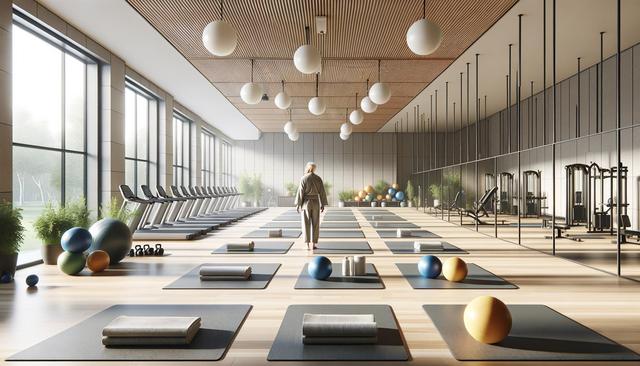The Growing Importance of Senior Fitness
As more people are living longer, the focus on healthy aging has become increasingly important. Seniors are getting active again, recognizing the value of exercise not only for longevity but also for enhancing quality of life. Fitness centers dedicated to older adults are responding with programs designed specifically to meet the needs of this age group. These facilities prioritize safe, accessible, and supportive environments that encourage participation regardless of prior fitness experience. As mobility and strength can decline with age, guided exercise helps maintain independence, reduces risk of falls, and improves daily functioning.
Regular physical activity also contributes to emotional and mental well-being. Studies show that seniors who engage in consistent exercise routines experience reduced symptoms of anxiety and depression. Social interaction in group classes and shared spaces also plays a vital role in combating isolation, which can be common among older adults. By combining physical movement with social engagement, fitness centers serve as community hubs where seniors can connect, stay motivated, and keep their minds sharp.
Tailored Programs for Every Ability Level
One of the key advantages of gyms designed for seniors is the availability of customized programs that cater to a wide range of fitness levels and health conditions. Unlike general fitness centers, senior-focused facilities employ trained professionals who understand the unique physical limitations and goals of older adults. Exercise plans are adapted to individual needs, whether someone is recovering from surgery, managing a chronic condition, or simply looking to stay mobile.
Common offerings in senior gyms include:
- Low-impact aerobic classes
- Balance and fall prevention training
- Strength-building routines using resistance bands or light weights
- Flexibility-focused sessions such as yoga or stretching
- Water aerobics, which are gentle on joints
These activities are designed to be engaging, manageable, and goal-oriented. Participants often progress at their own pace, with plenty of support from instructors and peers. This inclusivity helps build confidence and encourages ongoing participation, which is crucial for long-term health benefits.
Benefits Beyond Physical Health
While the physical benefits of exercise are widely understood, the mental and cognitive advantages are just as significant. Regular movement has been linked to improved brain function, memory retention, and reduced risk of cognitive decline. For seniors, this means that staying active can play an important role in maintaining independence and mental sharpness as they age. Exercise stimulates the release of endorphins, which elevate mood and energy levels, often leading to a more positive outlook on life.
Social wellness is another critical aspect supported by senior fitness centers. Group settings foster friendships, reduce feelings of loneliness, and encourage accountability. Whether it’s chatting before a class or sharing progress with a workout buddy, these interactions contribute to emotional resilience. Many centers also offer wellness workshops and educational seminars, adding layers of value beyond physical training.
Creating a Safe and Supportive Environment
Safety is a top priority in gyms for seniors. Equipment is chosen for ease of use and accessibility, and facilities are designed to minimize risk. Flooring is often non-slip, and spaces are arranged to allow for movement aids like walkers or canes. Staff members are trained in first aid and CPR, and many centers have protocols in place to monitor participants’ health during workouts.
In addition to physical support, emotional encouragement is central to the experience. Instructors take time to learn each member’s abilities and limitations, offering modifications as needed. This personalized attention ensures that everyone feels included and capable, regardless of their starting point. For many seniors, this environment provides the reassurance they need to embark on or continue their fitness journey without fear of injury or embarrassment.
Staying Consistent for Long-Term Wellness
Consistency is key to achieving and maintaining fitness goals, especially for older adults. Senior fitness centers often use motivational tools such as progress tracking, goal-setting sessions, and milestone celebrations to help members stay engaged. Incentives like group challenges or themed workout weeks add variety and excitement, keeping routines fresh and enjoyable.
Family involvement can also enhance consistency. Some centers offer intergenerational programs or encourage family visits, helping bridge gaps and create shared experiences. Transportation services and flexible class schedules make it easier to attend regularly, even for those with mobility or logistical challenges.
Ultimately, the goal of these programs is to instill a sense of empowerment and self-care. By making fitness a regular part of their lifestyle, seniors can enjoy improved health, greater independence, and a stronger sense of community.
Conclusion: Embracing Active Aging
Senior-focused fitness centers are more than just places to exercise—they are gateways to a healthier, more engaged lifestyle. With tailored programs, supportive environments, and a strong emphasis on physical and mental wellness, these gyms are helping older adults rediscover the joys of movement and connection. As seniors continue to get active again, their commitment to fitness becomes a powerful testament to the possibilities of active aging. Whether it’s taking a first step or maintaining a long-standing routine, every movement contributes to a fuller, more vibrant life.




Leave a Reply